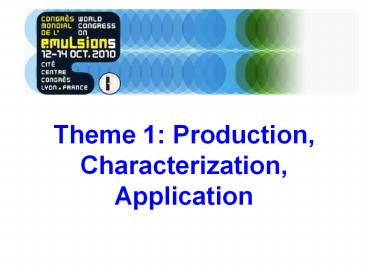Theme 1: Production, Characterization, Application PowerPoint PPT Presentation
1 / 11
Title: Theme 1: Production, Characterization, Application
1
Theme 1 Production, Characterization, Application
2
Workshop 1.1 Emulsification processes and
equipment
- Statistics
- 27 communications (19 from academia 8 from
industry) - Main work-streams
- Microfluidic and membrane devices improving
- Rotor-stator (RS) and High pressure (HP)
homogenizers - main interest to industry - Process optimization and intensification
- Understanding the basic mechanisms.
- Applying emulsion techniques to produce
particles - Other methods are also tested ultrasound, thin
film spinning, CO2 responsive emulsions
3
- Noticeable results
- Intensification by emulsification at high
internal phase (50-90 vol ). - Simplified geometries of homogenizer heads with
preserved high performance - Significant step in increasing the microfluidic
production (EDGE device, asymmetric plates).
4
Workshop 1.2 Micro- and milli-fluidics applied to
emulsions
- Statistics
- 13 communications coming from academia
- Main work-streams
- Droplets formation and manipulation
- Understanding mechanisms
- Droplet formation well understood
- Coalescence mechanisms at the scale of some
droplets ongoing activity - Production of specific emulsions / particles
- Microflidics as a tool for characterization
(interfacial rheology, viscosity)
5
- Noticeable results
- New mechanism of drop formation in membrane
emulsification hint for optimized pore geometry - Tailored processes to achieve drop morphology
- Nano-channel emulsification (submicron droplets)
- In some cases - specific and high grade particles
or droplet assemblies. - Main problem
- Still does not comply with industrial demands
6
Workshop 1.3 Physical stability, Rheology
- Statistics
- 17 from academia and 13 from industry
- Remarks
- Several companies offer instruments for stability
and microrheology characterization (LUM,
Formulaction, Malvern, .) - Opaque systems can be characterized.
- Attempts to understand macroscopic stability by
analysis of several structural levels (e.g.
influence of surfactant structure on ripening and
coalescence).
7
- Perspectives
- Different versions of light scattering and
optical microscopy analysis seem to be most
versatile and found wide application. - Commercial instruments for microrheology are
already on the market
8
Workshop 1.4 Interfaces and dynamic behaviours
- Statistics
- 20 communications from academia and 6 from
industry - Main work-streams
- Characterization of complex mixtures - synergy
(surfactant polymer, particles,
cosurfactant) - Improvement of instruments and data analysis for
surface characterization - High frequency (fast) processes
- Cationic surfactants for bitumen applications
- Bitumen stability and surface properties
9
- Noticeable results
- Clear distinction between the role of particles
(as good stabilizers) and surfactants (as fast
adsorbing emulsifiers) - Progress in understanding the relation bitumen
emulsion surface properties.
10
Workshop 1.5 End use properties and innovative
industrial applications
- Statistics
- 10 contributions from academia and 9 from
industry - Remarks
- Interest in developing correlations between
physical properties of emulsions and use
properties - Explore how to improve quality and end use
properties with the help of systematic studies - New insight into psycho-rheology (relation
between physic-chemical properties and human
perception)
11
Workshop 1.6 Bitumen emulsion and road material
properties
- Statistics
- 5 communications from academia and 16 from
industry - Main work-streams
- Cold mixes
- Behavior of grave emulsion on jobsites
evolution of mechanical properties and emulsifier
binder - Methodology to improve formulation and mix design
- Environment
- Warm mixed asphalt
- Microsurface
- Market studies

